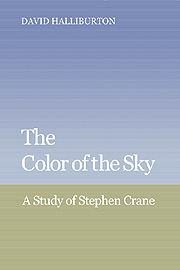Book contents
- Frontmatter
- Contents
- 1 Introduction
- 2 The Little: Early Writings
- 3 Conflict as Condition: Maggie: A Girl of the Streets
- 4 Doing Without: George's Mother
- 5 Eternal Fact and Mere Locality: The Red Badge of Courage: An Episode of the American Civil War
- 6 The Mysteries of Heroism and the Aesthetics of War: Army Tales and Other War Writings
- 7 Community and Crisis: “The Monster,” Tales of Whilomville, “The Blue Hotel,” “The Bride Comes to Yellow Sky”
- 8 The Ethics of Their Condition and the Unreal Real: “The Open Boat,” “The Five White Mice”
- 9 The Farther Shore: Poems
- Notes
- Index
3 - Conflict as Condition: Maggie: A Girl of the Streets
Published online by Cambridge University Press: 06 July 2010
- Frontmatter
- Contents
- 1 Introduction
- 2 The Little: Early Writings
- 3 Conflict as Condition: Maggie: A Girl of the Streets
- 4 Doing Without: George's Mother
- 5 Eternal Fact and Mere Locality: The Red Badge of Courage: An Episode of the American Civil War
- 6 The Mysteries of Heroism and the Aesthetics of War: Army Tales and Other War Writings
- 7 Community and Crisis: “The Monster,” Tales of Whilomville, “The Blue Hotel,” “The Bride Comes to Yellow Sky”
- 8 The Ethics of Their Condition and the Unreal Real: “The Open Boat,” “The Five White Mice”
- 9 The Farther Shore: Poems
- Notes
- Index
Summary
The opening of Crane's first novel, which appeared in 1893 as Maggie: A Girl of the Streets (A Story of New York), recalls the close of “The Mesmeric Mountain”: “A very little boy stood upon a heap of gravel for the honor of Rum Alley. He was throwing stones at howling urchins from Devil's Row who were circling madly about the heap and pelting at him” (p. 3). The protagonist of each narrative is little, isolated, elevated, and menaced, and each reacts defiantly, the one throwing pebbles, the other stones. As the occupant of the heap, the little boy is a version of the little man as the heap of gravel is a version of a mountain; but there is a difference. While the man's position, having been freely assumed, lends a splendor of isolation, the boy's does not. Social reality has become so much a matter of mere oppugnancy that conflict goes on by itself, interminably: Conflict, to use a word that becomes prominent in the New York City sketches, is a “condition.”
CONFLICT AS CONDITION
A current of energy that must always flow somewhere, conflict can be interrupted, stalled, or diverted, but it cannot be shut off. In this strange economy of strife the advent of Pete, who breaks up the fight, illustrates the significance in Crane of the outsider, who appears as the novice or the innocent one (The Red Badge of Courage, “Death and the Child”); the monster, in the story of the same name; the newcomer (“The Bride Comes to Yellow Sky”); the foreigner (“One Dash – Horses,” “A Man and Some Others”), or the newcomer who is also a foreigner (“The Blue Hotel”).
- Type
- Chapter
- Information
- The Color of the SkyA Study of Stephen Crane, pp. 38 - 70Publisher: Cambridge University PressPrint publication year: 1989



